PRACTICE PROBLEMS ON CUBIC EQUATION USING SYNTHETIC DIVISION
Subscribe to our ▶️ YouTube channel 🔴 for the latest videos, updates, and tips.
Completely factor and find all zeros for each polynomial :
(1) x3 + 4x2 + 5x + 2
(2) x4- x3 + 14x2 - 16x - 32
(3) 5x3+29x2+19x-5
(4) 4x3 - 9x2 + 6x - 1
(5) 3x4- 10x3 - 24x2 - 6x + 5
(6) 3x3 + 9x2 + 4x + 12
(7) Find the remainder of
f(x) = x3 + x2 - 6x - 7 divided by x + 2
(8) Find the value of a if x - 3is a factor of
f(x) = x3 - 11x + a
(9) Find the value of k if
f(x) = 3(x2 + 3x - 4) - 8(x - k)
is divisible by x.
(10) If -1 and 1 are two real roots of the polynomial function
f(x) = ax3 + bx2 + cx + d
and (0, 3) is the y-intercept of the graph of f, what is the value of b ?

Problem 1 :
x3 + 4x2 + 5x + 2
Solution :
Let p(x) = x3 + 4x2 + 5x + 2
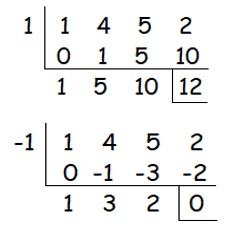
By dividing the cubic polynomial by 1, we get 12 ≠ 0.
Dividing by -1, we get 0 as remainder. So, -1 is one of the solutions.
From the bottom row, we create a quadratic polynomial. By factoring this, we will get two factors.
x2+3x+2 = (x+1) (x+2)
x3+4x2+5x+2 = 0
(x+1) (x+1) (x+2) = 0
Equating each factor to zero, we get
x + 1 = 0, x + 1 = 0 and x + 2 = 0
x = -1, -1, -2
So, the solution is {-1, -1, -2}
Problem 2 :
x4- x3 + 14x2 - 16x - 32
Solution :
Let p(x) = x4- x3 + 14x2 - 16x - 32
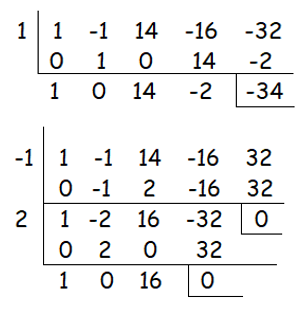
By dividing the fourth degree polynomial by 1, we get -34≠0.
By applying the value of x as -1 and 2, we get the remainder as 0.
So, the factors are (x+1) and (x–2)
So far we got two roots of the given polynomial.
By solving,
x2 + 16 = 0
x2 = -16
x = √-16
x = ±4i
So, it has a imaginary root.
x4- x3 + 14x2 - 16x - 32
x + 1 = 0 and x - 2 = 0
x = -1, 2
So, the solution is {-1, 2, ±4i}
Problem 3 :
5x3+29x2+19x-5
Solution :
Let p(x) = 5x3+29x2+19x–5
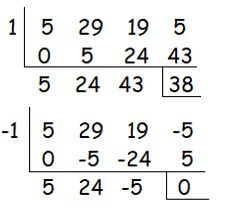
By dividing the cubic polynomial by 1, we get 38≠0. Dividing by -1, we get 0 as remainder. So, -1 is one of the solution.
By factoring
quadratic polynomial 5x2 + 24x – 5, we get
5x2 + 24x - 5 = (5x - 1) (x + 5)
(5x - 1) (x + 5) = 0
Equating each factor to zero, we get
x = -1, 1/5, -5
So, the solution is {-1, 1/5, -5}
Problem 4 :
4x3 - 9x2 + 6x - 1
Solution :
Let p(x) = 4x3 - 9x2 + 6x - 1
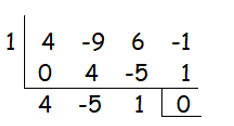
By dividing the cubic polynomial by 1, we get 0 as remainder. So, 1 is one of the zeroes of the polynomial.
By factoring quadratic polynomial 4x2 - 5x + 1, we get
4x2 - 5x + 1 = (4x – 1) (x – 1)
The factors are (x – 1) (4x – 1) (x – 1)
Equating each factor to zero, we get
(x – 1) (4x – 1) (x – 1) = 0
x = 1, 1/4, 1
So, the solution is {1, 1/4, 1}
Problem 5 :
3x4- 10x3 - 24x2 - 6x + 5
Solution :
Let p(x) = 3x4- 10x3 - 24x2 - 6x + 5
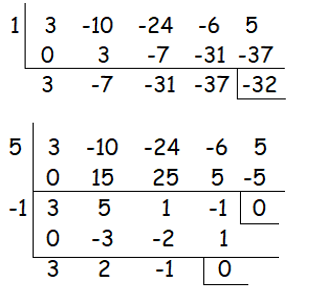
By dividing the fourth degree polynomial by 1, we get -32≠0. So dividing by 5, we get 0 as remainder,
Both x = 5 and x = -1 are the two zeros of given polynomial.
By factoring quadratic polynomial 3x2 + 2x - 1, we get
3x2 + 2x - 1 = (3x – 1) (x + 1)
Equating each
factor to zero, we get
(3x – 1) (x + 1) = 0
x = 1/3, -1
So, the solution is {5, -1, 1/3, -1}
Problem 6 :
3x3 + 9x2 + 4x + 12
Solution :
Let p(x) = 3x3 + 9x2 + 4x + 12
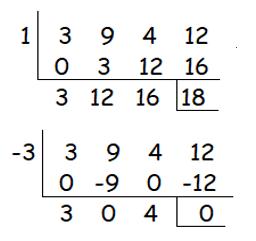
By dividing the cubic polynomial by 1, we get 18≠0. Dividing by -3, we get 0 as remainder. So, -3 is one of the zeroes of the given polynomial.
By solving,
3x2 + 4 = 0
3x2 = -4
x = √-4/3
x = ±2/√3i
So, the solution is {-3, ±2/√3i}.
Problem 7 :
Find the remainder of
f(x) = x3 + x2 - 6x - 7 divided by x + 2
Solution :
x + 2 = 0
x = -2
f(x) = x3 + x2 - 6x - 7
Applying x = -2 in the polynomial, we get
f(-2) = (-2)3 + (-2)2 - 6(-2) - 7
= -8 + 4 + 12 - 7
= -15 + 16
= 1
So, the remainder is 1.
Problem 8 :
Find the value of a if x - 3 is a factor of
f(x) = x3 - 11x + a
Solution :
f(x) = x3 - 11x + a
Since x - 3 is a factor, x - 3 = 0. Then x = 3, and 3 is a zero of the polynomial.
f(3) = 33 - 11(3) + a
0 = 27 - 33 + a
0 = -6 + a
a = 6
So, the value of a is 6.
Problem 9 :
Find the value of k if
f(x) = 3(x2 + 3x - 4) - 8(x - k)
is divisible by x.
Solution :
f(x) = 3(x2 + 3x - 4) - 8(x - k)
Since it is divisible by x, x = 0 is a solution.
f(0) = 3(02 + 3(0) - 4) - 8(0 - k)
0 = 3(-4) - 8(-k)
0 = -12 + 8k
8k = 12
k = 12/8
k = 3/2
So, the value of k is 3/2.
Problem 10 :
If -1 and 1 are two real roots of the polynomial function
f(x) = ax3 + bx2 + cx + d
and (0, 3) is the y-intercept of the graph of f, what is the value of b ?
Solution :
f(x) = ax3 + bx2 + cx + d
Since -1 is a root, when x = -1, f(-1) = 0
Since 1 is a root, when x = 1, f(1) = 0
f(-1) = a(-1)3 + b(-1)2 + c(-1) + d
0 = -a + b - c + d -------(1)
f(1) = a(1)3 + b(1)2 + c(1) + d
0 = a + b + c + d -------(2)
The curve passes through the point (0, 3), then
f(0) = a(0)3 + b(0)2 + c(0) + d
3 = d
(1) + (2)
2b + 2d = 0
Applying d = 3, we get
2b + 2 (3) = 0
2b = -6
b = -3
So, the value of b is -3.
Subscribe to our ▶️ YouTube channel 🔴 for the latest videos, updates, and tips.
Kindly mail your feedback to v4formath@gmail.com
We always appreciate your feedback.
About Us | Contact Us | Privacy Policy
©All rights reserved. onlinemath4all.com
Recent Articles
-
10 Hard SAT Math Questions (Part - 40)
Dec 23, 25 06:12 AM
10 Hard SAT Math Questions (Part - 40) -
AP Calculus BC Problems with Solutions
Dec 20, 25 10:51 AM
AP Calculus BC Problems with Solutions -
AP Precalculus Problems and Solutions (Part - 1)
Dec 20, 25 10:49 AM
AP Precalculus Problems and Solutions (Part - 1)
